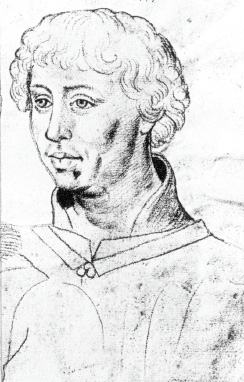
Charles, Count of Charolais, later Duke of Burgundy, (from a drawing in the ‘Recueil d’Arras’)
Philippe de Commynes, Seigneur d’Argentan, chronicler and councillor to Louis XI (from a drawing in the ‘Recueil d’Arras’)
David Garrick as Richard III (1741) shows the King awakening from his nightmare in the royal tent before Bosworth – with prominence given to the crown, crucifix and next to his boar-crested helm on the ground (left) the warning note left to Norfolk. Engraving from a painting by William Hogarth
The ‘Courtrai Chest’, a carved wooden panel representation of the fourteenth-century battle
Ludlow Castle, from which the Duke of York’s family scattered in 1459 as their Lancastrian enemies advanced. Cecily and her two youngest sons, George and Richard, remained to face them
The man who should have been king: figure of Richard, Duke of York, the warrior-father, whose martial values and reputation so deeply influenced his youngest son. Trinity College, Cambridge
Fotheringhay Church, Northants. The memorial to Richard, Duke of York, Cecily Neville and Edmund, Earl of Rutland, their son, erected by order of Queen Elizabeth I, 1573, to replace the desecrated original
Yorkist badges of Falcon, Fetterlock and White Rose, on a choir stall from Fotheringhay Church, now at Tansor, Northants
Thomas, Duke of Clarence, younger brother of Henry V, killed at Baugé (1421). Detail from his alabaster effigy at Canterbury Cathedral
Baynard’s Castle, Thames-side residence of Cecily Neville in the Yorkist period, scene of dynastic plotting and scandalous revelations
Cecily Neville, Duchess of York. Detail from the frontispiece of the ‘Luton Guild Book’, c. 1475. She is shown here kneeling before the Trinity, with the piety which defined the latter stages of her life. Her youth may have been rather different
Seal of Cecily Neville, mother of Edward IV and Richard III: formidable matriarch and dynastic schemer, a woman with a secret that would shake the realm of England to its foundations
Charles VIII, King of France
Stylised representation of Edward V, the boy king who almost certainly perished with his younger brother in the Tower. Painting on the screen of the Oliver King Chantry, St George’s Chapel, Windsor
Rouen Cathedral, scene of the extraordinarily elaborate christening ceremony held for Edmund, second surviving son of the Duke of York and Cecily Neville. Their son and heir Edward had earlier been christened in a private chapel
Alabaster effigy of Elizabeth, Duchess of Suffolk, sister of Edward IV and Richard III (Wingfield Chuch, Suffolk). Her intercession in October 1476 engineered a temporary reconciliation between Cecily Neville and Edward IV’s queen
The white boar badge of Richard III, carved detail from the pulpit, a gift of Edward IV to Fotheringhay Church, Northants
Top: Gold medallion of Constantine
Bottom: Gold medallion of St Helena
Details from spandrels of the Richard III portrait, Windsor
I ‘turned in my heart’ from him. Isabella of Castile, who was alienated from a match with Edward IV by his demeaning choice of bride
‘Only pawns in their game’: Left: Princesses Elizabeth, Cecily and Anne;
Right: Princesses Katherine and Mary, daughters of Edward IV, from the ‘Royal window’, Canterbury Cathedral
Fotheringhay Church, from the south. The imposing tower was built by Richard, Duke of York
A mother’s pride – effigy of Margaret Beaufort (in Westminster Abbey), mother of Henry Tudor and champion of his fortunes
The great gatehouse and closet tower, Raglan Castle, Gwent, raised by William, Lord Herbert, where Henry Tudor spent part of his childhood and adolescence as Herbert’s ward
The father he never knew: brass to Edmund Tudor (d. 1456), father of Henry VII, St David’s Cathedral, Pembrokeshire
Reconstruction of Nottingham Castle as it appeared in the reign of Richard III, based on a ground plan of 1617. Richard III built the tower in the centre background
Brass memorial (laid down in 1525) commemorating Sir John Sacheverell and his wife Joan, at Morley Church, Derbyshire. The inscription relates that he was killed fighting for Rihard III at Bosworth Field
The best and most courageous action Richard undertook. The defence of Hornby Castle, Lancashire, by the Harrington family, was supported by Richard as Duke of Gloucester in the early 1470s and inspired the distrust of the acquisitive Stanleys
Leading from the front: soldiers bear a conspicuous royal battle helmet with crown for an English king. Detail from the sovereign’s stall, St George’s Chapel, Windsor
Effigy in Salisbury Cathedal of Sir John Cheney (d. 1499), who was flung out of the way by Richard III in his final despeate confrontation with his Tudor challenger
Effigy of Sir Henry Vernon (d. 1528), Tong Church, Shropshire. Richard III’s letter to him before Bosworth revealed his wish to employ cavalry against his Tudor challenger
Statues of St Armel (or Armaglius), St Kenelm and St Lawrence, in ‘Innocent’s Corner’, above the urn containing bones interred as those of the princes in the Tower, by Charles II, Henry VII Chapel, Westminster Abbey
St Armel stained glass, Merevale Church
St Armel south aisle of Henry VII Chapel, Westminster Abbey
Reconstruction of Merevale Abbey as it may have appeared before the Dissolution of the Monasteries in 1538. By P. A. Baker from a conjectural design by John D. Austin
The church of St Mary, Merevale, was originally the gate chapel of the Cistercian Abbey